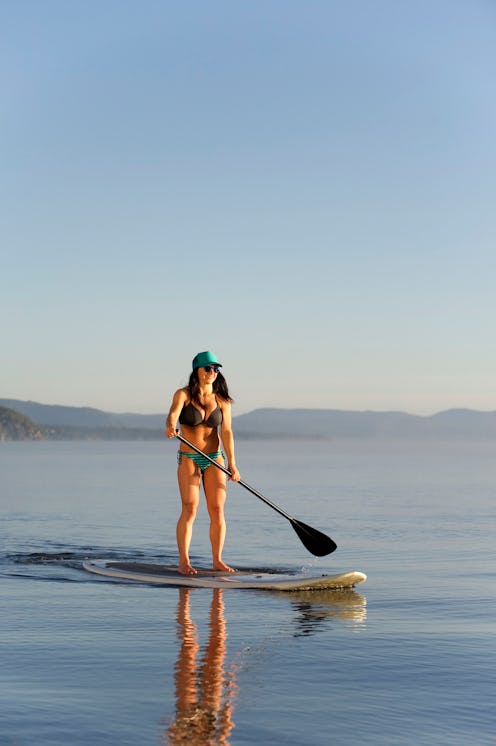kali9/E+/Getty Images
Paddleboarding, or SUP (stand-up paddleboarding), is an activity that’s a lot like kayaking because you have to paddle. It’s also similar to surfing because you can stand up on the board, says FIELDHOUSE fitness director Ryan Kennedy. Here, 11 benefits of paddleboarding to know.
Shutterstock
It Targets The Core
The act of balancing while using a paddle to navigate on the water will engage your core muscles, says Kennedy. Your obliques, in particular, will get stronger as you repeatedly twist your torso to paddle on each side of the board without tipping over.
Corey Jenkins/Image Source/Getty Images
Works Upper Body
Your back, biceps, and shoulders will also get in on the action, says Paddlefit trainer Kim Evans. Instead of paddling with just your arms, you’ll eventually learn to hinge at the hips to make it a full-body movement. That’ll give you more power, she tells Bustle.
Shutterstock
Engages Lower Body
Paddleboarding also calls on the muscles of your lower body — the hamstrings, glutes, quads, and calves — to keep you steady and balanced on the board, says trainer Hannah Daugherty.
Shutterstock
It Works The Feet
Even your feet get a workout when paddleboarding. The reason? “You need good foot strength to stay stable,” trainer Jesse Feder tells Bustle. As you learn how to stand up, you’ll find that you spread your toes to effectively grip the board.
Shutterstock
Improves Balance
“Standing on a paddleboard can be tricky at first,” Kennedy says. You have to learn how to center your body by engaging leg and core muscles while adapting to changes in the water. “This is an amazing way to improve body awareness as well as overall balance.”
Shutterstock
Good Cardio
Paddling is a cardio workout on its own, but add choppy water, wind, and currents and then you’ll really start to sweat. “It’s common to be paddling for 15 to 20 minutes while only moving 10 feet forward,” Kennedy says. “This is a great way to build endurance.”
Shutterstock
Low Impact
SUP is considered a low impact sport, Daugherty says, because it doesn’t create any wear and tear on your joints. For an extra-chill experience, paddle gently and take it easy.
Gary John Norman/The Image Bank/Getty Images
It Gives You Vitamin D
It’s a great outdoor workout — which means paddleboarding helps boost your vitamin D levels as well as your immune system, Kennedy says. Do, however, remember to bring a hat, sunglasses, and/or sunblock if you’ll be on the water for hours.
Shutterstock
It Can Lower Blood Pressure
The act of paddling across a serene lake can be extremely meditative, Kennedy adds. Kneel or sit on your board and paddle at an easy pace, and the experience may even effectively lower your blood pressure.
Shutterstock
It’s Relaxing
Perhaps most important of all? Paddleboarding is relaxing. As trainer TJ Mentus says, you get to be in nature, which releases feel-good hormones to boost your mood. It also gives your brain a break from other thoughts as you focus on nothing but paddling. Aaah...
